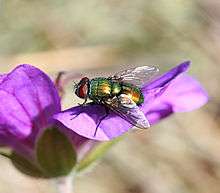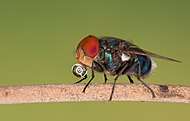Green bottle fly
The name green bottle fly or greenbottle fly is applied to numerous species of Calliphoridae or blow fly, in the genera Lucilia and Phaenicia (the latter is sometimes considered a subgenus of the former).
| Green bottle fly | |
|---|---|
 | |
| Scientific classification | |
| Kingdom: | |
| Phylum: | |
| Class: | |
| Order: | |
| Family: | |
| Genera | |
| |
Distribution
These flies are found in most areas of the world, primarily the Western Hemisphere and especially California and Australia, and the most well-known species is the common greenbottle, Lucilia sericata (or Phaenicia sericata, depending on authority), though there are other common species such as Lucilia caesar, Lucilia cuprina, Lucilia coeruleiviridis, and Lucilia illustris.
Uses
The maggots of this fly are known to preferentially consume dead tissue while leaving live tissue intact, so have been sold for use in maggot therapy, primarily during the years before the widespread use of antibiotics and medicines and in modern times due to a resurgence of medical literature documenting their effectiveness. These flies are known to lay eggs in cadaver tissue in the wild within hours after death. The developmental stage of their larvae in the cadaver can be used for accurate determination of the time of death.
Gallery
 Lucilia sericata
Lucilia sericata
